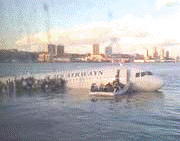Bird Strike Committee Proceedings

Bird Strike Committee-USA/Canada Joint Annual Meeting: 10th (2008)
Date of this Version
8-2008
Document Type
Article
Abstract
Pacific Habitat Services began trapping, color marking and translocation of Red-tailed Hawks at Portland International Airport (PDX) in October 1999 in response to a high number of red-tail bird strikes. Initially, all red-tails were targeted for capture and translocation. Subsequent observations of returning birds led to the current practice of identifying and leaving resident adults and focused trapping efforts on non-resident, transient and migratory hawks. PDX strike data strongly supports the assumption that resident adults are less likely to be struck than non-residents. The data also suggests that residents with more experience are less likely to be struck than those with less experience and that the location of some territories may make them more hazardous than others. Of 70 confirmed red-tail strikes occurring January 2000 - December 2007 only three were of resident breeding adult red-tails. We suggest that leaving airport savvy hawks on territory as placeholders reduces the likelihood that inexperienced birds will move in to occupy that territory. In addition, resident adults actively chase non-resident and inexperienced hawks away from the airfield further reducing the number of higher risk hawks and the associated potential bird strikes. At present, PDX manages seven pairs of resident Red-tailed Hawks. To date, over 600 red-tails have been captured at PDX. Trapping and translocation is not a standalone method; it is used along with nest intervention, habitat modification, prey base management and hazing to reduce the likelihood of red-tail bird strikes.


Comments
Abstract of paper presented at Bird Strike Committee USA/Canada Meeting, Lake Mary and Sanford, Florida, August 18–21, 2008.